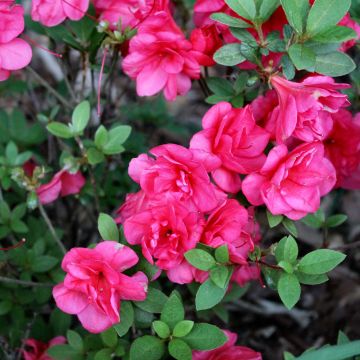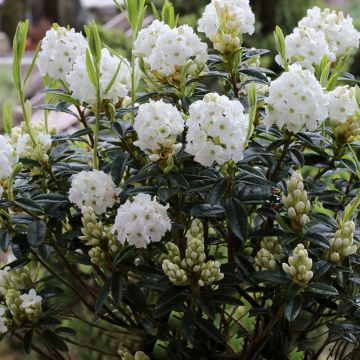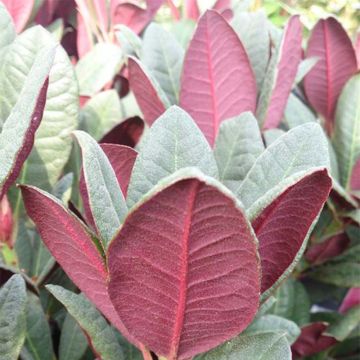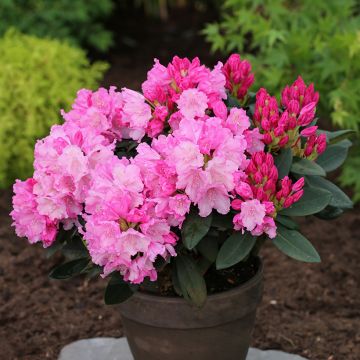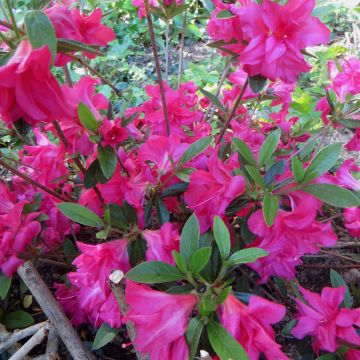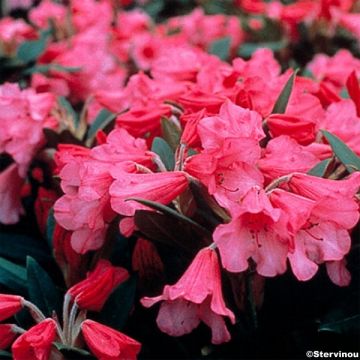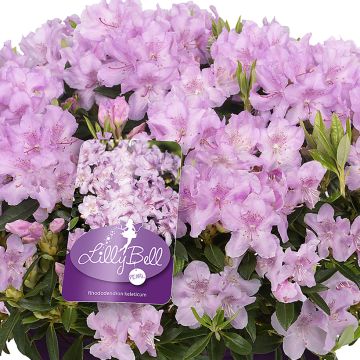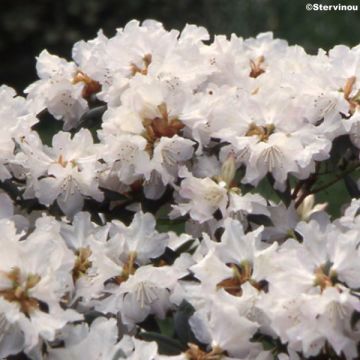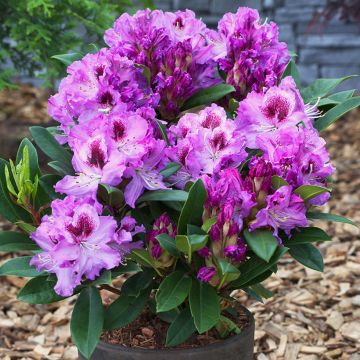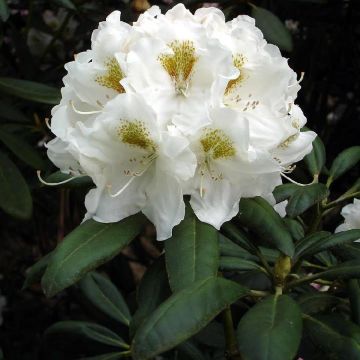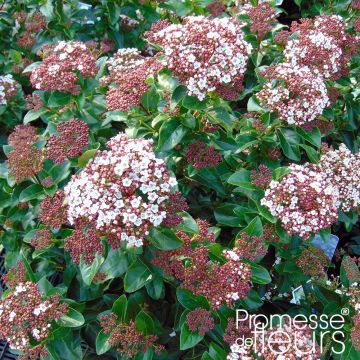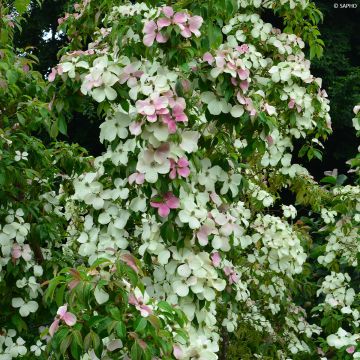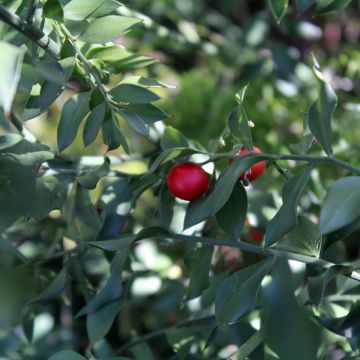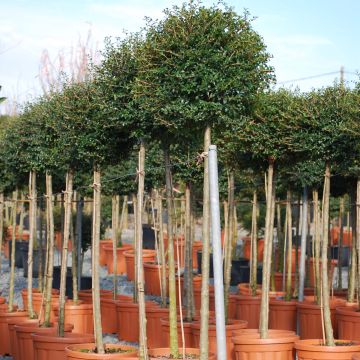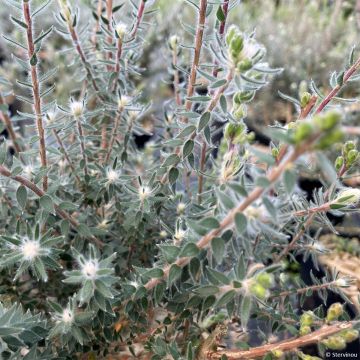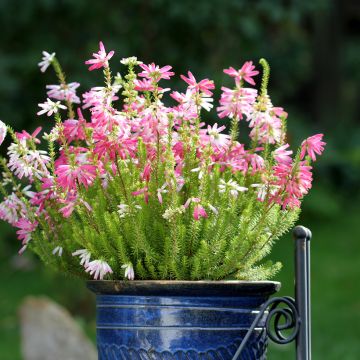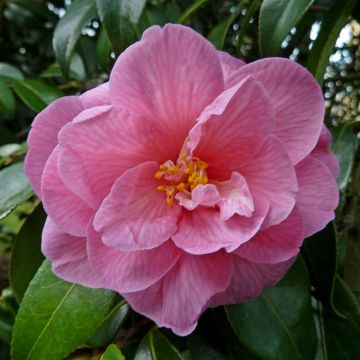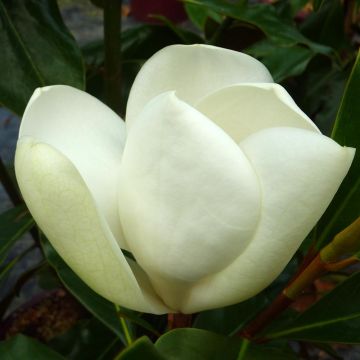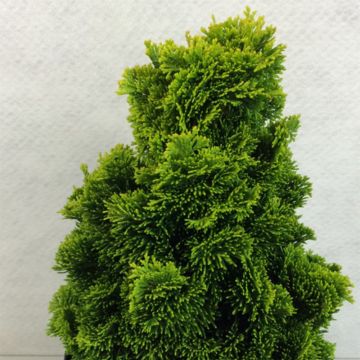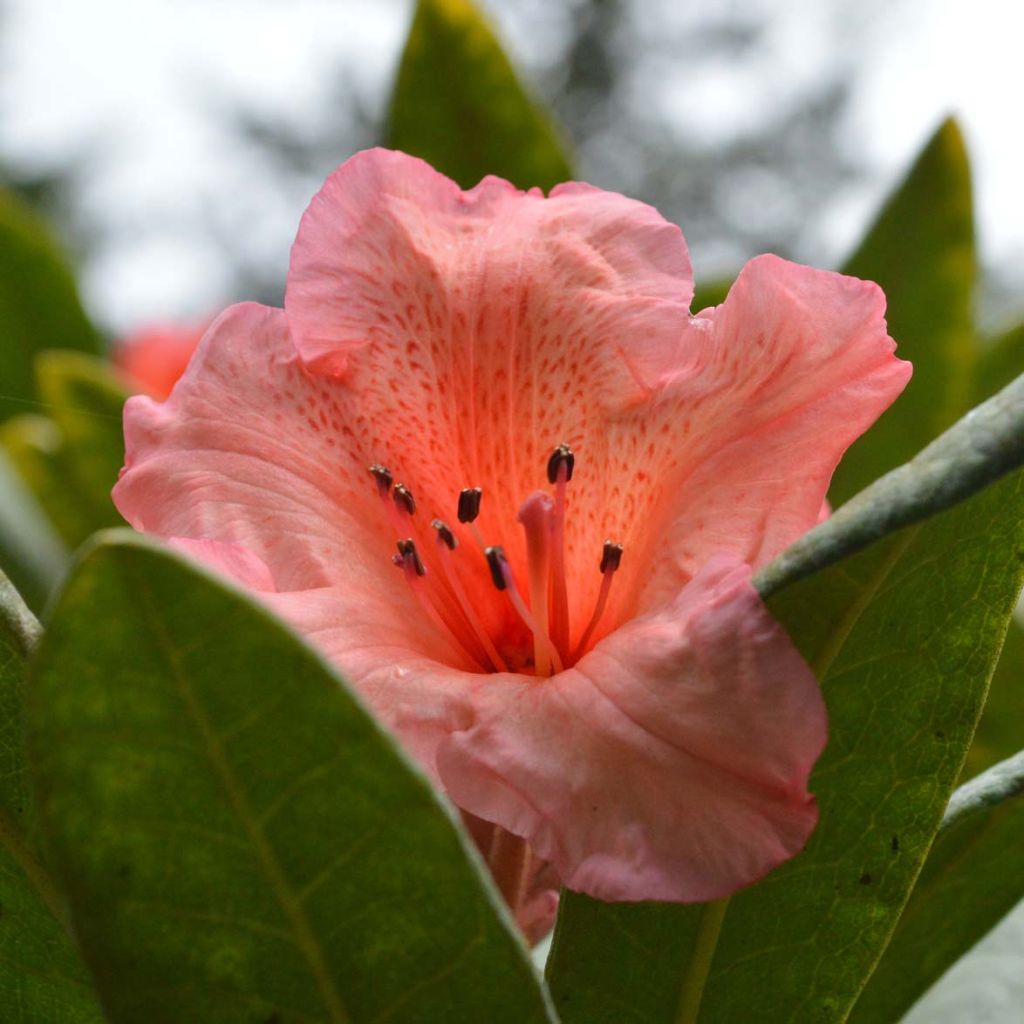

Rhododendron Tortoiseshell Orange
Rhododendron Tortoiseshell Orange
Rhododendron Tortoiseshell Orange
Rhododendron
This item cannot be shipped to the selected country
Delivery charge from €5.90
More information
Schedule delivery date,
and select date in basket
This plant carries a 24 months recovery warranty
More information
We guarantee the quality of our plants for a full growing cycle, and will replace at our expense any plant that fails to recover under normal climatic and planting conditions.
From €5.90 for pickup delivery and €6.90 for home delivery
Express home delivery from €8.90.

Does this plant fit my garden?
Set up your Plantfit profile →
Description
Rhododendron 'Tortoiseshell Orange' is an ancient English hybrid with a unique personality. Aside from its flowering, it is instantly recognizable by its beautiful evergreen foliage. The particularly narrow and elongated leaves are a very dark green. At the end of May, it stands out with its gently flamboyant flowering: its large flowers, borne in loose clusters full of charm, evolve from pale yellow to orange-red, with shades of pink and salmon. With its moderate growth and attractive character all year round, this Rhododendron is one of the most original! Plant it in an ericaceous bed or a large container, in partial shade or dappled sunlight.
Rhododendrons are plants from the heather family, preferring predominantly lime-free, acidic soils and humid climates. 'Tortoiseshell Orange', obtained in England in 1947, is a cross between the variety 'Goldsworth Orange' and the botanic species Rhododendron griersonianum.
'Tortoiseshell Orange', with its fairly slow growth, naturally forms a rounded and upright bush measuring 1.2 meters (4 feet) in height and 1 meter (3 feet) in width at 10 years old. The shrub shows a fairly regular, rounded, and compact silhouette. Its evergreen leaves, a very dark green with a slightly bluish hue and a satin finish, are closely lanceolate in shape and provide good coverage. The flowering of this variety is quite late, typically starting at the end of May. Clustered in loose groups of 5 to 12 at the ends of the branches, beautiful large flowers with slightly undulate edges bloom. The color ranges from pale yellow to soft orange-red, with various shades of warm pink, and the center of the flowers is more orange.
The 'Tortoiseshell Orange' Rhododendron is an attractive, hardy down to -15°C (5°F), and easy to grow shrub as long as the conditions suit it, in terms of exposure, soil, and climate. "Rhodos" are as exclusive as they are ornamental shrubs that thrive admirably in temperate climates in acidic soil. When they have a modest stature like 'Tortoiseshell Orange', they allow you to beautifully adorn a small semi-shaded space in the garden, as well as the terrace or balcony. For example, it can be planted alongside camellias, azaleas, deciduous magnolias, and pieris, which appreciate the same growing conditions and complement their spring flowering. Japanese maples bring lightness to their sometimes massive silhouettes. Hydrangeas, on the other hand, make good companions for summer and autumn. Spring or summer flowering bulbs (tulips, oriental lilies), as well as ferns, heucheras, and hostas, will occupy the foreground of large ericaceous bed plantings. Container cultivation requires regular watering with non-lime water and specific fertilizer for ericaceous plants. Large Rhododendrons, on the other hand, are absolutely stunning in a hedge.
Report an error about the product description
Rhododendron Tortoiseshell Orange in pictures
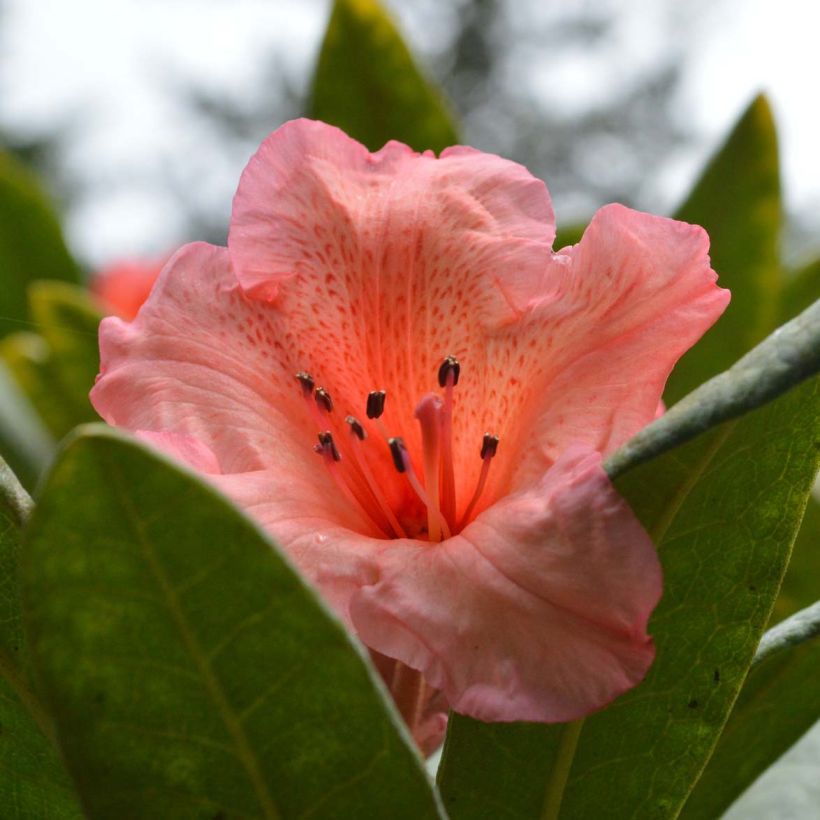

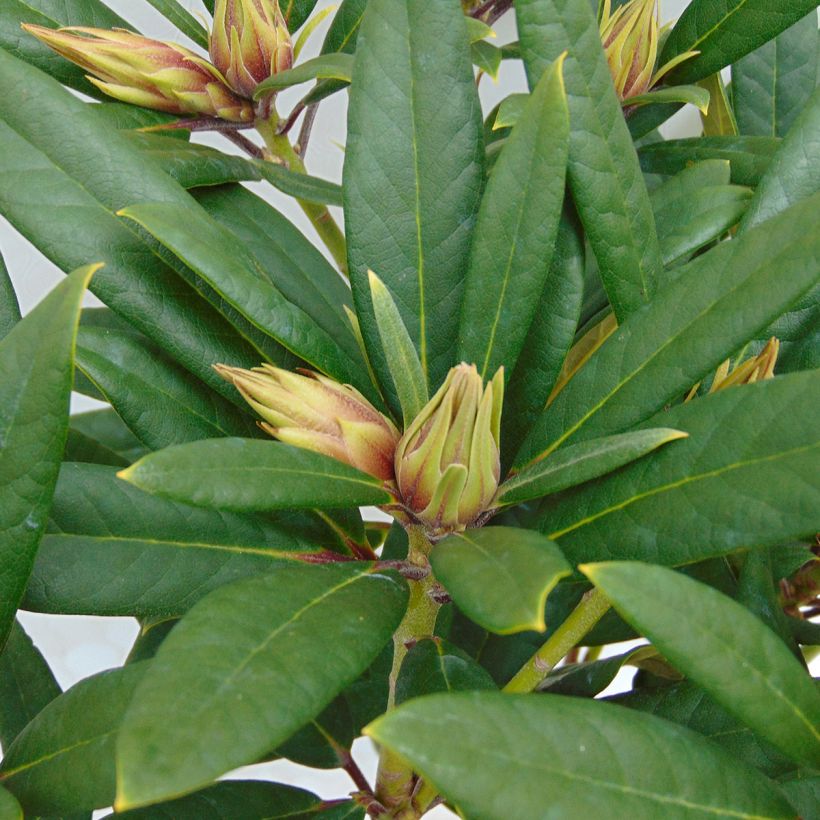

Plant habit
Flowering
Foliage
Botanical data
Rhododendron
Tortoiseshell Orange
Ericaceae
Rhododendron
Cultivar or hybrid
Other Small Rhododendron
Planting and care
Plant the 'Tortoiseshell Orange' Rhododendron in a semi-shaded position, protected from cold and drying winds, in a moist, humus-rich, and light soil, with a tendency to be acidic or neutral. Like all plants of the heathland, it cannot tolerate lime-free soils or heavy soils that become waterlogged in winter. If the soil remains moist in summer, this rhododendron can also tolerate exposure to non-scorching sunlight. Avoid planting at its base, as its shallow roots do not tolerate competition from other plants, especially for water resources.
Dig a hole three times larger than the pot. Soak the root ball in lime-free water and plant the bush at the collar level, in a mixture composed of leaf compost, gravel or pumice, and loam. Water generously and keep the soil moist in summer. Azaleas and Rhododendrons have a shallow root system. Therefore, they are susceptible to long periods of drought. That is why it is advisable to enrich the soil with humus and provide abundant watering during dry periods. Moreover, this root system is not very strong, so it is essential to lighten heavy soils with draining materials (gravel, pumice, clay balls) at planting. Apply mulch of shredded pine bark around the base of the bush every spring to maintain soil moisture and acidic pH.
Maintenance consists of removing faded flowers in summer and removing dead branches. Azaleas and Rhododendrons can sometimes be attacked by weevils that eat the edges of the leaves and rootlets, as well as the infamous "rhododendron beetle," which seldom causes severe damage. Effective biological solutions are available today against weevils. Yellowing of the leaves (chlorosis) in Rhododendron indicates poor assimilation of iron in the soil and can lead to premature plant death. While limestone is often the cause, poorly drained soil or deeply planted root balls can also explain the phenomenon.
Planting period
Intended location
Care
-
, onOrder confirmed
Reply from on Promesse de fleurs
Evergreen shrubs
Haven't found what you were looking for?
Hardiness is the lowest winter temperature a plant can endure without suffering serious damage or even dying. However, hardiness is affected by location (a sheltered area, such as a patio), protection (winter cover) and soil type (hardiness is improved by well-drained soil).

Photo Sharing Terms & Conditions
In order to encourage gardeners to interact and share their experiences, Promesse de fleurs offers various media enabling content to be uploaded onto its Site - in particular via the ‘Photo sharing’ module.
The User agrees to refrain from:
- Posting any content that is illegal, prejudicial, insulting, racist, inciteful to hatred, revisionist, contrary to public decency, that infringes on privacy or on the privacy rights of third parties, in particular the publicity rights of persons and goods, intellectual property rights, or the right to privacy.
- Submitting content on behalf of a third party;
- Impersonate the identity of a third party and/or publish any personal information about a third party;
In general, the User undertakes to refrain from any unethical behaviour.
All Content (in particular text, comments, files, images, photos, videos, creative works, etc.), which may be subject to property or intellectual property rights, image or other private rights, shall remain the property of the User, subject to the limited rights granted by the terms of the licence granted by Promesse de fleurs as stated below. Users are at liberty to publish or not to publish such Content on the Site, notably via the ‘Photo Sharing’ facility, and accept that this Content shall be made public and freely accessible, notably on the Internet.
Users further acknowledge, undertake to have ,and guarantee that they hold all necessary rights and permissions to publish such material on the Site, in particular with regard to the legislation in force pertaining to any privacy, property, intellectual property, image, or contractual rights, or rights of any other nature. By publishing such Content on the Site, Users acknowledge accepting full liability as publishers of the Content within the meaning of the law, and grant Promesse de fleurs, free of charge, an inclusive, worldwide licence for the said Content for the entire duration of its publication, including all reproduction, representation, up/downloading, displaying, performing, transmission, and storage rights.
Users also grant permission for their name to be linked to the Content and accept that this link may not always be made available.
By engaging in posting material, Users consent to their Content becoming automatically accessible on the Internet, in particular on other sites and/or blogs and/or web pages of the Promesse de fleurs site, including in particular social pages and the Promesse de fleurs catalogue.
Users may secure the removal of entrusted content free of charge by issuing a simple request via our contact form.
The flowering period indicated on our website applies to countries and regions located in USDA zone 8 (France, the United Kingdom, Ireland, the Netherlands, etc.)
It will vary according to where you live:
- In zones 9 to 10 (Italy, Spain, Greece, etc.), flowering will occur about 2 to 4 weeks earlier.
- In zones 6 to 7 (Germany, Poland, Slovenia, and lower mountainous regions), flowering will be delayed by 2 to 3 weeks.
- In zone 5 (Central Europe, Scandinavia), blooming will be delayed by 3 to 5 weeks.
In temperate climates, pruning of spring-flowering shrubs (forsythia, spireas, etc.) should be done just after flowering.
Pruning of summer-flowering shrubs (Indian Lilac, Perovskia, etc.) can be done in winter or spring.
In cold regions as well as with frost-sensitive plants, avoid pruning too early when severe frosts may still occur.
The planting period indicated on our website applies to countries and regions located in USDA zone 8 (France, United Kingdom, Ireland, Netherlands).
It will vary according to where you live:
- In Mediterranean zones (Marseille, Madrid, Milan, etc.), autumn and winter are the best planting periods.
- In continental zones (Strasbourg, Munich, Vienna, etc.), delay planting by 2 to 3 weeks in spring and bring it forward by 2 to 4 weeks in autumn.
- In mountainous regions (the Alps, Pyrenees, Carpathians, etc.), it is best to plant in late spring (May-June) or late summer (August-September).
The harvesting period indicated on our website applies to countries and regions in USDA zone 8 (France, England, Ireland, the Netherlands).
In colder areas (Scandinavia, Poland, Austria...) fruit and vegetable harvests are likely to be delayed by 3-4 weeks.
In warmer areas (Italy, Spain, Greece, etc.), harvesting will probably take place earlier, depending on weather conditions.
The sowing periods indicated on our website apply to countries and regions within USDA Zone 8 (France, UK, Ireland, Netherlands).
In colder areas (Scandinavia, Poland, Austria...), delay any outdoor sowing by 3-4 weeks, or sow under glass.
In warmer climes (Italy, Spain, Greece, etc.), bring outdoor sowing forward by a few weeks.

































